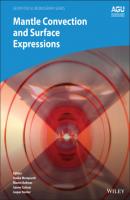Mantle Convection and Surface Expressions. Группа авторов
Чтение книги онлайн.

Читать онлайн книгу Mantle Convection and Surface Expressions - Группа авторов страница 58
Название: Mantle Convection and Surface Expressions
Автор: Группа авторов
Издательство: John Wiley & Sons Limited
Жанр: Физика
isbn: 9781119528593
isbn:
Figures 3.5d–f show the predicted fractions ϕ of d electrons that occupy each of the considered multi‐electron states for Fe2+ in ferropericlase and Fe3+ in bridgmanite and in the CF phase along different adiabatic compression paths. The change in electronic ground states from 5T2 (high spin) to 1A1 (low spin) for Fe2+ and from 6A1 (high spin) to 2T2 (low spin) for Fe3+ is gradual and broadens with increasing temperatures as suggested earlier (Holmström & Stixrude, 2015; Lin et al., 2007; Sturhahn et al., 2005; Tsuchiya et al., 2006). The crystal‐field model outlined above, however, predicts additional broadening that results from thermal population of the higher energy states 3T1 for Fe2+ and 4T1 for Fe3+. At realistic mantle temperatures, these states are predicted to host up to 25% of d electrons. Population of these states will reduce the effect of spin transitions on mineral densities and elastic properties by diluting the contrasts in properties between pure high‐spin and low‐spin states. The spin transition of Fe2+ in ferropericlase appears to be most susceptible to thermal broadening while spin transitions of Fe3+ in bridgmanite and in the CF phase remain somewhat sharper even at high temperatures.
The effect of spin transitions on P‐wave velocities is shown in Figures 3.5g–i as relative velocity reductions along typical adiabatic compression paths. In qualitative agreement with results of DFT computations for ferropericlase and Fe3+‐bearing bridgmanite (Shukla et al., 2016; Wentzcovitch et al., 2009; Wu et al., 2013), both the pressure interval and the pressure of maximum P‐wave velocity reduction increase with temperature. Absolute velocity reductions and their exact pressure intervals at high temperatures as predicted by DFT computations, however, seem to differ from those predicted by the semi‐empirical crystal‐field model. Figures 3.5g–i also show how ignoring the population of the higher energy states 3T1 for Fe2+ and 4T1 for Fe3+ would overestimate P‐wave velocity reductions at realistic mantle temperatures. Although I considered only one additional state for each Fe2+ and Fe3+, more high‐energy states might become populated at relevant temperatures, further depleting high‐spin and low‐spin ground states. Experiments at combined high pressures and high temperatures are needed to directly assess the thermal broadening of spin transitions and their effects on mineral elasticity. Since the volume changes that result from spin transitions can be subtle, in particular at high temperatures and for typical iron contents of mantle minerals (Komabayashi et al., 2010; Mao et al., 2011), experiments that constrain elastic properties in addition to volume might be best suited to resolve the impact of spin transitions on sound wave velocities at high temperatures.
Figure 3.5 (a–c) Reanalysis of elastic moduli of ferropericlase (a), sound wave velocities of bridgmanite (b), and compression data on the CF phase (c) across spin transitions of ferrous (a) and ferric (b,c) iron. Respective data are from Yang et al. (2015) (a), Chantel et al. (2012), and Fu et al. (2018) (b), and Wu et al. (2017) (c). Bold black curves show the results of fitting a semi‐empirical crystal‐field model to the data as explained in the text with the respective crystal‐field parameters given in each panel. The values of crystal‐field parameters that were free to vary during fitting are marked with an asterisk (*). For bridgmanite, data of Chantel et al. (2012) and Fu et al. (2018) have been analyzed together to better constrain pressure derivatives of elastic moduli. The offset between both data sets arises from slightly different estimates for densities as reported in both studies. (d–f) Fractions of d electrons in multi‐electron states across spin transitions of Fe2+ in ferropericlase (d), Fe3+ in bridgmanite (on B site) (e), and Fe3+ in the CF phase (f) as predicted by the semi‐empirical crystal‐field model and along typical adiabatic compression paths (see Figure 3.8). Shading indicates differences in fractions that result from starting adiabatic compression at temperatures 500 K above and below 1900 K at 25 GPa. (g–i) P‐wave velocity reductions that result from spin transitions of Fe2+ in ferropericlase (g), Fe3+ in bridgmanite (on B site) (h), and Fe3+ in the CF phase (i) as predicted by the semi‐empirical crystal‐field model and along adiabatic compression paths starting at 1400 K, 1900 K, and 2400 K at 25 GPa (see Figure 3.8). The dashed curves show P‐wave velocity reductions along the central compression path (1900 K at 25 GPa) when the population of a third multi‐electron state with intermediate spin multiplicity is ignored.
3.8 EARTH’S LOWER MANTLE
Seismic tomography shows lateral variations in P‐ and S‐wave velocities at all depths of the lower mantle and across length scales that are compatible with changes in temperature, chemical composition, and phase assemblage as well as combinations thereof (Durand et al., 2017; Hosseini et al., 2020; Koelemeijer et al., 2016). Scattering of seismic waves in the lower mantle, in contrast, points to changes in the elastic properties of the mantle over СКАЧАТЬ